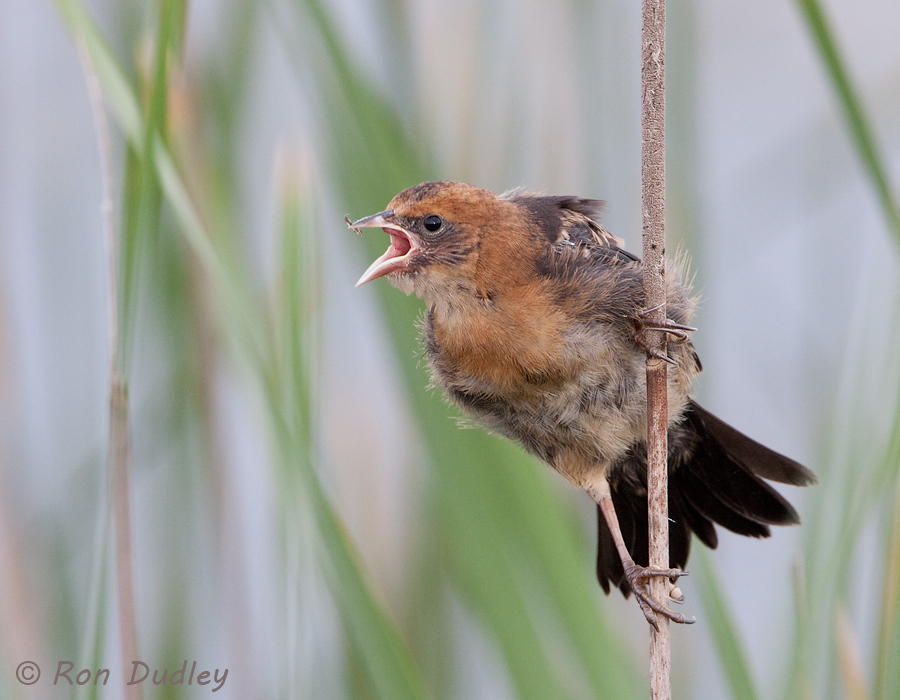Young Yellow-headed Blackbirds leave the nest long before they can fly, at the very early age of 9 – 12 days. From then until they can fly they spend their time hiding in the dead vegetation near the surface of the water and begging incessantly for food.
These blackbirds feed almost exclusively on seeds for most of the year but during the breeding season they become strict carnivores and consume vast numbers of insects, particularly emergent aquatic species. In Utah, midges, damselflies, grasshoppers and beetles are the primary insect types delivered to the young birds by the parents.
1/250, f/7.1, ISO 500, 500 f/4, 1.4 tc, natural light
This youngster had the begging routine down to a science. It spent its time buried in the cattails until it spotted a parent nearby, when it would come out and beg with very enthusiastic calls and postures. As you can see it has an insect leg stuck to its bill from a previous meal. Once the young birds learn to fly they pursue the parents as they beg for food which can produce a scene of real pandemonium in an area with multiple nests.
Here’s a link to a sound file of the begging calls of juvenile Yellow-headed Blackbirds if you’re interested.
The marsh where I photographed this bird has been a prolific breeding ground for Yellow-headed Blackbirds for many years but last year they apparently abandoned the area for breeding. I don’t know why.
Ron
Note: My primary computer is now in the shop for a few days and for a variety of reasons publishing posts is a real struggle with my back-up machines. All I can do is take each day one at a time.
Note #2. I just noticed that comments from several of you who are regulars here and whose comments should have been pre-approved have been going to my spam folder for some reason. Hopefully I have remedied that situation but if it ever happens again please let me know through “contact me” at the top of the page. I apologize to those it happened to.



When comparing habitat requirements/preferences of yellow-headed black birds v. red-winged blackbirds, and yellow-headed need/prefer deeper water. Was it a dry year?
Good article and superb photograph! This past year, observing bird families has been educational and more than a little entertaining!
Very evocative!
Love the reserve breakfast. The begging is infinitely more musical than our fledgling galahs. If only I could I would feed them just to stop the noise. Which obviously irritates the adults too – I have seen an adult firmly rap a whinging youngster on the head. We applauded.
Our magpies continue to beg for quite some time. One explanation I have heard which makes some sense is that their beaks are still relatively soft, and not up to being plunged into our sun-baked ground after insects.
I loved this picture. Ron, you have perfectly captured it.
Len
One recent spring we had a blue jay family, a Downey woodpecker family, a chickadee family and one other I forget all begging their poor parents to feed them. The din was awful and Having raised several birds myself, I felt so bad for the poor, relentlessly persuade parents. The baby blackbirds are cute, but I’ll bet almost nightmarish to their parents.. I cringe to this day when I hear baby crows or blue jays calling for food.
Patty, the most obnoxious young birds in that way I’ve observed are Western and Clark’s Grebes. And their begging behaviors last for many weeks. Those adults have endless patience with them, however. Quite admirable but I surely couldn’t do it.
Fantastic shot and very interesting Ron!
Charlotte
I’m glad you enjoyed it, Charlotte.
Babies are so demanding! Love the bug.;-)
Yes, they are demanding – especially birds. Thank you, Deb.
Enchanting!
I’ll happily wait until your primary computer is returned for subsequent posts.
Thanks, Alison, I appreciate the thought but at this point I prefer to post daily if I can. I put the pressure on myself and I’m fine with that. I just wanted readers to know what’s going on in case I can’t post daily.